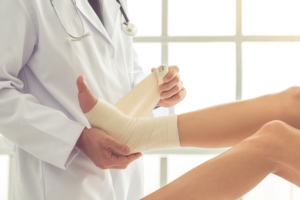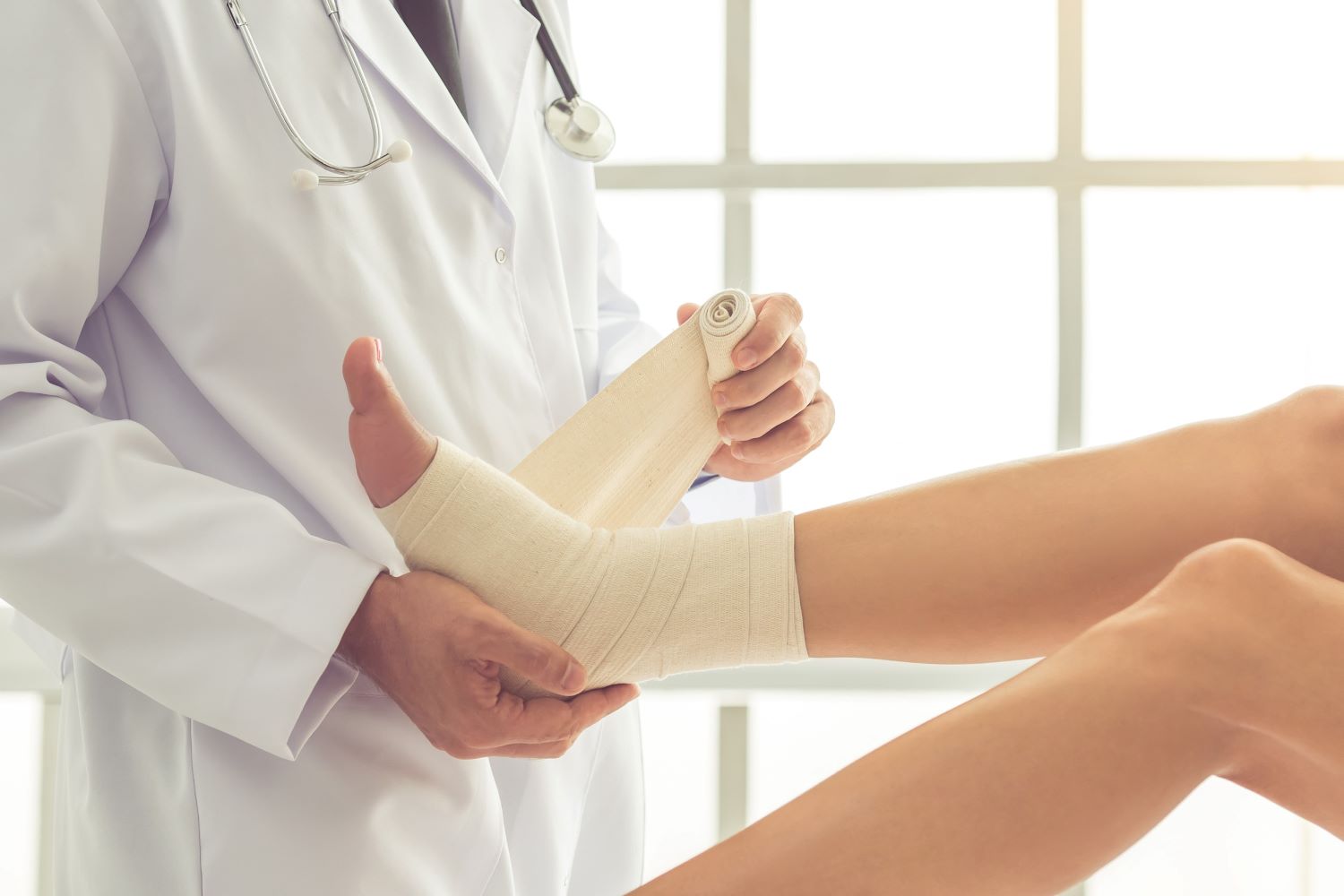What is a Unna Boot?
An Unna Boot is a compression bandage that is applied by a healthcare provider to treat slow healing lower leg wounds and ulcers (commonly caused by venous stasis ulcers).
An Unna boot, named after the German dermatologist Paul Gerson Unna, is a type of bandage designed to manage various leg conditions, particularly those involving edema or swelling. It consists of a soft, gauze or cotton bandage impregnated with zinc oxide paste, often mixed with calamine lotion. This paste provides a soothing effect and helps to reduce inflammation and swelling while promoting healing.
The bandage is wrapped around the affected leg in a spiral configuration, applying gentle pressure to alleviate swelling and encourage proper circulation. Elastic wrap is often used to keep the bandage in place, ensuring that it remains snugly covered on the leg. The Unna boot has been proven effective in managing edema and other conditions like venous stasis ulcers by providing consistent compression and support to the affected area.
Since it is named after the German dermatologist Paul Gerson Unna, rather than call it an Unna boot, many state it should be called an Unna’s boot. But most people just call it an Unna boot.
An Unna Boot is an Alternative to Other Dressings
The Unna boot stands out as a versatile alternative to traditional bandages and compression wraps in wound care management. Unlike elastic wraps or other dressings, the Unna boot is uniquely designed to create a semi-rigid yet flexible covering that conforms closely to the affected area.
Its impregnated gauze with zinc oxide paste which helps maintains moisture levels, promoting a moist wound healing environment while providing gentle, consistent compression to reduce swelling.
This innovative approach not only supports the healing process but also protects the skin from irritation and breakdown. One can generally engage in normal daily activities while wearing the Unna boot, thanks to its secure yet comfortable form. Unna boots offer a cost-effective and convenient solution for managing wounds and edema, making them a preferred choice for healthcare providers and patients alike.
When to Use an Unna’s Boot?
An Unna boot is typically utilized in various clinical scenarios to address acute or chronic conditions affecting the lower extremities. It proves particularly beneficial in cases where there’s a need to decrease edema or swelling while providing consistent compression like leg ulcers. Based on published evidence and their experience, healthcare professionals often prescribe Unna boots for those experiencing moderate drainage from wounds or ulcers on the legs or ankles.
The process involves applying a specialized zinc oxide paste-soaked gauze bandage to the affected area in a spiral wrap configuration, creating a snug yet comfortable covering. This method not only promotes healing but also helps to stabilize the affected limb and reduce discomfort. Unna boots are especially effective when standard dressings or compression hose alone may not suffice, ensuring optimal wound management and enhancing the overall healing process. Published evidence supports that they are effective when venous stasis ulcers are present.
How Does Unna Boot Compression Therapy Work?
An Unna Boot is a gauze wrap that is soaked with a zinc oxide paste. The zinc oxide paste helps ease skin irritation and keep the area moist.

Typically the Unna’s boot is placed on the leg from the base of the toes, past the ankle to just below the knee, the zinc oxide paste is then covered with a dry gauze wrap followed by an ace bandage. The wrap dries a few hours after application.
The Unna’s boot has two functions that help keep leg ulcers area moist and heal: the compression helps reduce swelling, while the medicated zinc oxide cream (such as calamine lotion and zinc oxide paste) helps prevents drying and itching while in the Unna boot. Glycerin is sometimes used for its effectiveness in wound healing as glycerin can also keep a wound moist. Glycerin, however is not a standard component of an Unna boot.
While in an Unna Boot for Leg Ulcers, You Should:
- Elevate your leg as much as possible, above the level of your heart. This is especially important for those with edema from lymphedema or venous stasis ulcers.
- Avoid prolonged sitting or standing when you have an Unna boot.
- Keep the Unna’s Boot bandages dry while getting this treatment for leg ulcers.
- Walk daily to promote muscle contraction.
- Continue any normal daily activities.
Do Not:
- Put any objects into the boot to relieve itching while getting this treatment.
- Walk long distances until the Unna Boot bandages is dry (3-4 hours).
- Wear a compression stocking over the Unna Boot bandages (socks and shoes are okay).
- Get the boot wet in the shower or bath while getting this treatment.
- Get rest when needed.
At Home Tips:
- Since the pressure dressings is 3 layers thick with zinc oxide paste over the ulcer, the patient may need to wear a slipper or a shoe over the foot or ankle that is larger than your normal size while the ulcer is healing with these bandages.
- A plastic bag can be placed and taped over the bandages on the foot and leg when showering since the bandage has cotton and you want to keep the bandage dry.
- Call your provider or seek medical attention if there is pain or numbness.
- The more knowledge you have about how to manage your Unna boot the better so learning from these resources can be helpful.
Can You Use an Intermittent Pump with an Unna Boot On?
Using an intermittent pneumatic pump (IPP) with an Unna boot requires careful consideration and should be done under the guidance of a healthcare professional. While the combination is not common due to the potential risk of compromising the compression provided by the Unna boot, there may be situations where it is deemed appropriate.
The IPP delivers intermittent compression to improve circulation and reduce swelling, which may conflict with the compression provided by the Unna boot. Therefore, it’s essential to assess the individual’s specific condition, the goals of treatment, and the compatibility of both interventions before implementing them together.
Consulting with a healthcare provider experienced in wound care is crucial to ensure safe and effective management of the patient’s condition.
How Often Should Unna Boots be Changed?
An Unna Boot can be left on for up to 7 days before it needs to be changed because they lose pressure as the leg gets smaller from the pressure dressings. Patients usually return to the clinic to have their boot changed once or twice per week until the wound or ulcer has healed with the aid of this elastic pressure dressings.
At each clinic visit, the state of the wound will be assessed to determine if another Unna Boot needs to be applied.
Patients may need to use Unna Boots for a few weeks until their venous ulcers fully heal and stops draining from the extra pressure from the elastic zinc oxide impregnated dressing. This is similar when it is used for patients with lymphedema with drainage from wounds. Usually, the Unna Boot impregnated with zinc oxide paste and calamine lotion needs to be applied multiple times until the skin irritation improves and the patient can be transitioned to a dry compression bandage, dry compression wrap, elastic wrap, or graded compression stocking.
When Are You Done With the Unna’s Boot?
Generally when the venous ulcers close, or if there was moderate drainage and the treatment appears to be working as the skin feels better, the skin irritation is less and the wounds are at least dry enough to put on a compression sock. It is very satisfying for patients to see the compression bandages from the Unna’s boot come off and see the skin irritation is improved and the venous ulcers have closed or in some cases healed. Then they can transition from the Unna’s boot to compression bandage or traditional compression socks to manage their swelling which is critical to keep venous ulcers closed. For patients with lymphedema and moderate drainage, the wounds heal with the compression dressing and then they don’t need the cover from the boot or wound dressing they needed before. Because the area has been moist, and the skin irritation is improved, the itching often goes down with the moist cotton pressure dressing bandage, especially around the ankle and the dressings can be switched to compression stockings.
For patients with venous ulcers, this can be a time to talk about getting treated for their underlying lower leg chronic venous insufficiency with approaches such as Closurefast RFA, Venaseal and Varithena.
Unna Boot Complications
Along with the intended effects, some side effects of wearing Unna Boots may occur. Call your health care provider if you experience any of the following:
- New pain
- Numbness of the foot or toes
- Discoloration of the toes
- Cold toes
- Foul odor
- Hives, itching or skin rash
- Excessive drainage
- Unna Boot gets wet or soiled or start to fall off
- Clinical infection
What Happens After Unna Boot Therapy?
Once the wound has healed, we often perform vascular studies to determine if there are additional opportunities to help speed recovery.
Depending on your condition, we may help you consider modern vein treatments like Closurefast RFA, Venaseal and Varithena, which – when combined with a comprehensive treatment plan – can help wounds close quicker and stay closed for longer when indicated.
Have a Wound or Venous Stasis Ulcer that May Need Treatment?
At Inovia Vein Specialty Centers, we focus on managing issues related to including venous stasis ulcers, varicose veins, DVTs and more.
To learn more about wound and vein treatments, fill out our Online Appointment Request Form or call any of our clinics in Northwest Portland, Tigard, Happy Valley, Hillsboro or Bend, Oregon.
